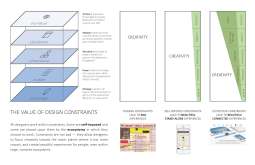An often-held viewpoint is that we need to “remove all constraints from designers – let them be creative!” On the surface, this sounds great – but in actual fact, the opposite is true.
Now that I’ve made that provocative statement, let me explain.
Design is not Art, Art is not Design. Artists create things to ask questions, they follow no rules, no set process. Designers, on the other hand, create things to answer questions – they solve problems, they follow rules, they have constraints. (See here for more).
Some of those constraints designers impose upon themselves. They understand and constrain themselves to the mission of their client and what they’re trying to achieve; they understand and constrain themselves to what is technologically feasible; they understand and constrain themselves to their users’ mental models – how they think about the world; they understand and constrain themselves to human abilities related to ergonomics and usability and they understand and constrain themselves to aesthetics that humans find pleasing and simple.
Using these self-imposed constraints, designers can create beautiful stand-alone experiences (e.g. the Uber app).
There are, however, another set of constraints – those imposed upon designers when they choose to work within an existing, large ecosystem. Those designers understand and constrain themselves to only add the features and functions that are complementary to the ones already in the ecosystem; they understand and constrain themselves to connecting their designs to the rest of the ecosystem; they understand and constrain themselves to creating predictable patterns of interaction to make the ecosystem easier to use and they understand and constrain themselves to the brand of the ecosystem, to present a unified, cohesive whole.
Using these ecosystem constraints, designers can create beautiful connected experiences (e.g. the Apple ecosystem of products, packaging, stores, digital, etc.)
Many large organizations have recognized this and have created design systems to encourage their designers to direct their creative energies in productive directions and not reinvent the wheel. (US Government, NASA, Google)
Constraints are not bad; in fact they’re necessary, if you don’t believe me, how about Charles Eames?
“Here is one of the few effective keys to the design problem — the ability of the designer to recognize as many of the constraints as possible — his willingness and enthusiasm for working within these constraints. Constraints of price, of size, of strength, of balance, of surface, of time and so forth.”


0 Responses to “Creativity vs. Constraints”